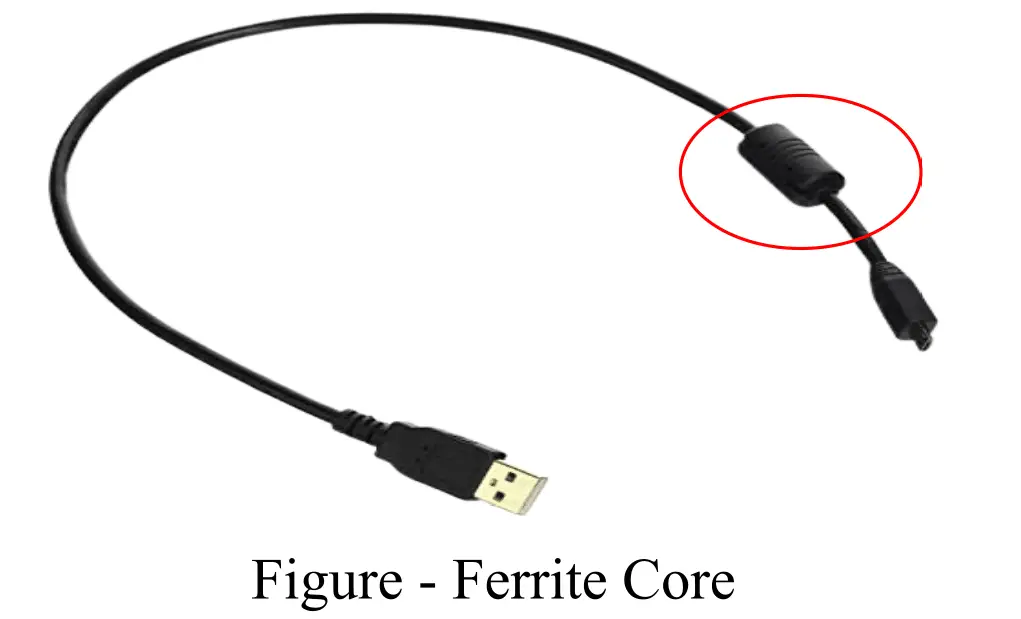In this article, we will discuss the definition, purpose, and working of the ferrite core used on the cables. So let’s begin with the definition of the ferrite core.
What is a Ferrite Core?
A magnetic core which is made up of ferrite materials such as a mixture of iron oxide (Fe2O3) and a small portion of other metallic elements such as nickel, zinc, manganese, barium, etc. is referred to as a ferrite core.

A ferrite core has high magnetic permeability (i.e. ability to establish magnetic flux in the material easily), low iron losses (eddy current loss and hysteresis loss) at high frequencies, and low electrical conductivity. The ferrite core is used on cables to reduce the electronic noise and common mode currents in the cable.
Ferrites have Mn-Zn ferrite and Ni-Zn ferrite according to the composition. Mn-Zn ferrite is conductive, therefore it requires insulation work. The Ni-Zn ferrites have better high-frequency characteristics compared to Mn-Zn ferrites. Therefore, Ni-Zn ferrite is often used for noise reduction.
Purpose of Ferrite Core in Cables?
The ferrite core is installed on the cables as shown in the above figure. The ferrite core reduces the electronic noise and common mode current through the cable. The ferrite core is used in such cable that carries sensitive electric signals such as video signals, audio signals, etc.
These signals are greatly affected by the electronic noise signal of high frequencies. Therefore, we have to use ferrite cores to suppress the electronic noise in the cables. Hence, we can say that the ferrite cores act as a filter for high-frequency noise signals.
Working of Ferrite Core
Ferrite core suppresses the electromagnetic emissions (i.e. electronic noise) by blocking the low-frequency noise signals and absorbing the high-frequency noise signals. In this way, the ferrite cores reduce the electromagnetic interference in circuits.
How Ferrite Core Reduces Noise Signals in Cable:
Consider a cable carrying both data signal and noise signal through it. These two types of signals produce a magnetic field around the cable. Generally, the frequency of the noise signal is relatively higher than the data signal. Thus, the noise signal produces a magnetic flux of high frequency. Now, when we install a ferrite core on the cable, it provides a path of high permeability for this high-frequency magnetic flux to pass. When the high-frequency magnetic flux flows through the ferrite core, it is converted into heat energy due to core losses. In this way, the ferrite core consumes the energy of the noise signal and hence reduces the noise signals in the cable.
When current flows to an inductor that has a ferrite core, magnetic flux generates in the ferrite core. In this process electrical energy converts into magnetic energy. However, with a change in the electric current, the magnetic energy gets converted back into current by electromagnetic induction. The whole energy conversion process is not completely reversible and some part of the energy is lost in the form of heat. This happens because of hysteresis loss. Thus, a part of the noise current passing through the conducting wires is lost as magnetic loss..
How Ferrite Core Reduces Common Mode Current in Cables:
Sometimes, a portion of electric current flowing through a cable has leaked through a new path such as ground, metallic parts, etc. that surrounds the cable and returns to the power supply is called common mode current. It is called common mode current because the direction of currents through the positive wire and the negative wire is the same. In practical circuits, the common mode current is undesired and thus needs to be eliminated.
In order to reduce the common mode current, we use a ferrite core in the form of an inductor. This inductor will induce a magnetic flux in the core when a current flows through the cable. This arrangement gives an increasing impedance with the increasing frequency (because the common mode currents usually have a frequency of more than 30 MHz) in the path of the common mode current. Therefore, the high impedance of the inductor with ferrite core (called common mode choke) reduces the common mode current.

Thus, the common mode choke provides a high impedance to common-mode currents and a low impedance to differential-mode currents.
Benefits of Ferrite Core
The following are the important advantages of ferrite cores-
- Ferrite cores can suppress high-frequency noise through the cables.
- Ferrite cores help in generating a clearer signal in the intended circuit.
- Ferrite cores work as the filter for electromagnetic interference.
- Ferrite cores have high resistance to high currents.
- Ferrite cores provide very low eddy current losses over a wide range of frequencies.
- Ferrite cores have very high permeability.
Installation of Ferrite Core on a Cable
The installation of the ferrite core on cables is quite simple. We just need to pass the cable through the ferrite core and circle the cable around the ferrite core for four turns.